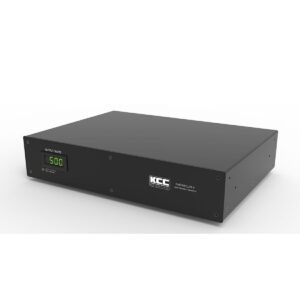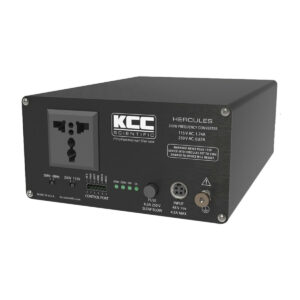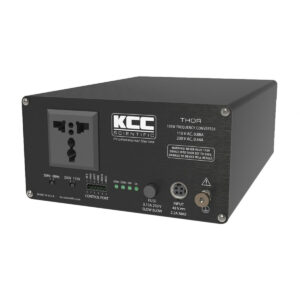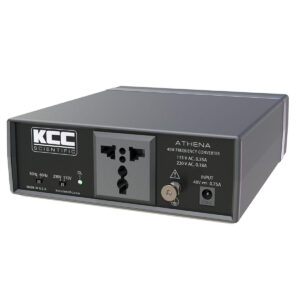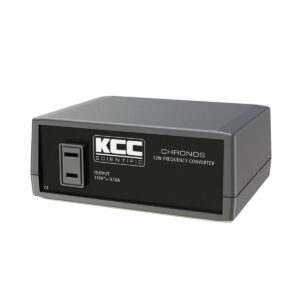Converters for Home and Hobby
KCC Scientific converters address the power challenges for miniature household appliances used overseas, from clocks to medical devices to model trains. To assure operation as intended on any power grid, a combined voltage and frequency converter is the best solution. KCC converters are available at multiple wattage levels to match the needs of the appliance or system.
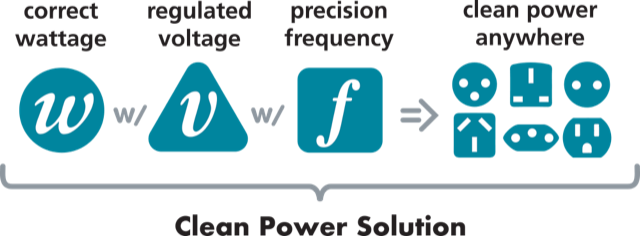

As an example, model railroad train transformers designed for use in the United States typically have a 115V AC 60Hz power requirement. If the system’s train transformer is run in Europe with a step-down transformer alone (converting only voltage from 230V to 115V AC at a frequency of 50 Hz), the transformer may begin to “saturate.” When it does, it may very seriously overheat. It’s often recommended that the voltage into the train transformer be lowered perhaps 20% (to about 95V AC or so). This leaves insufficient power to drive the locomotive and accessories, leading to numerous malfunctions. Using KCC Scientific converters avoids malfunctions.
-
500 and 1000 Watt Mercury Voltage and Frequency Converter- Conditioner
$1,449.00 – $2,395.00 Select options This product has multiple variants. The options may be chosen on the product page -
200 Watt Hercules Voltage and Frequency Converter
$699.00 Select options This product has multiple variants. The options may be chosen on the product page -
100 Watt Thor Voltage and Frequency Converter
$449.00 Select options This product has multiple variants. The options may be chosen on the product page -
40 Watt Athena Voltage and Frequency Converter
$299.00 Select options This product has multiple variants. The options may be chosen on the product page -
12 Watt Chronos Frequency Converter
$199.00 Select options This product has multiple variants. The options may be chosen on the product page
HOME AND HOBBY FAQ
What converter do I need?
1. Choose the Converter you need by how many WATTS of power your device needs, or more…
2. Locate the information on the power tag on the device. See examples below.
3. Can’t find a tag. Google the model number of the electronic device to find a product manual.
4. All KCC Scientific Converters are Universal, meaning they can power your device anywhere in the world. Simply select frequency and voltage your electronic device needs from the front panel. Plug it in.
5. Still not sure, contact us here and we will help. www.kccscienttific.com/contact/
Examples of Power Tags:

The top electronic device needs 700 watts or more of power. Mercury is recommended, it powers electronics 1000 watts or less.
The second device, a ceiling fan, requires 60 watts of power. 100 Watt Thor will do the job. Thor powers 100 watts or less.
Why Do I Need a Frequency Converter? I will just buy an inverter.
Let’s walk through some of the inverter vs frequency converter challenges.
- You will not be able to access one syllable of product support advice from the inverter manufacturer. So what happens if things don’t work out technically? And there’s a long list of possible problems. Read on…
- You will have a difficult time finding the proper voltage and frequency converter device where you are. For example, if you live in the USA, it is difficult to find a 230V AC 50Hz inverter locally.
- You will need to evaluate the inverter for its DC output component. This can be a serious issue if you are thinking about powering audio equipment with input transformers, or a large train transformer.
- A single inverter cannot provide settable frequency or output voltage.
- An inverter frequency accuracy is usually 1% at best…and some are as bad as 5%. For devices requiring exact timing, this simply isn’t going to work. On the higher end of that error limit, you will quite audibly hear the pitch error if you are powering a turntable. We know some folks who can detect pitch error at a fraction of 1%. If you want to power a drill or saw out in some remote location away from household power, then yes, this level of accuracy would be fine.
- Packaging, packaging, packaging. You probably don’t want a sine wave inverter designed to work at a campsite, a bundle of wires, some loose electronic parts, and an open-frame power supply next to your expensive turntable, tube preamplifier, or jukebox.
- You may need a LARGE battery and charger. Many inverters are designed assuming they are powered by batteries. Stay safe! The amperage requirements could start the wires on fire or melt the interconnects if you do not engineer them properly. And, some batteries are explosion hazards in the presence of sparks. Select the charger carefully; some will boil out the battery electrolyte.
- You’ll need to protect the battery from deep discharge. This will require a level detector and a switch. For this, selecting an inverter with a remote “on” input might be helpful.
- Substituting a DC power supply for a battery requires engineering knowledge. It may work, if you are willing to do some electronics integration and select a compatible power supply. You’ll need to evaluate the instantaneous power requirements of many inverters and the electronic device you may be trying to power. Some have such high values of input capacitance that many power supplies cannot start them.In the process of properly solving this problem, you may end up with a power supply more expensive than the inverter. You may also need some properly chosen capacitors and filters in the path between the power supply and the inverter. Consider how to select them and why they are needed–and how to protect them. You could get lucky and things will work out, but for how long? For example, what if the inverter fails and shorts out the power supply?
- You will not get customer support from an inverter company on how to integrate the pieces together. You will be on your own if something goes wrong or the inverter stops working due to an error you make.
- You will not get quality isolation. This isn’t what inverters are designed for. So be prepared for high-frequency ground loops and all the associated noise problems.
- You may end up with RF (radio frequency) interference. When you connect two switching devices together, even if each is certified for RF emissions, it is a gamble as to what the interaction between them will be.
- Consider cost, better inverters are appropriately pricey. Others may be audibly or electrically noisy. Most of the time, they’re just not designed for quality or precision. KCC Scientific products are! With our products, you won’t have to think about any of the above issues. With the DIY path, you need to engineer your way out of every problem you encounter, now and later.
Of course, you could keep it simple and buy a KCC Scientific Voltage and Frequency Converter. It’s similar to the philosophy behind a smart phone. You could buy a standard telephone, a portable computer, a camera, audio recorder, video camera, large battery, and carry all of those around with you. Or, you could buy a smart phone. Why buy the pieces and put together a DIY “frequency converter” (which may not work reliably) when it is infinitely easier to buy a well-thought out, tested, accurate and safe KCC Scientific product that works perfectly and is integrated elegantly?
There are a multitude of reasons why KCC Scientific products are perfect for the job at hand. Plus, you won’t get better customer support anywhere. That’s why we’re here!
Have questions? Contact us here
To view frequency and voltage converters for purchase click here: SHOP
Why do I need a frequency converter? I will just buy a transformer.
By now you know equipment designed to uniquely operate in one part of the world may not be compatible in another. Perhaps you may have purchased a “travel converter kit” made up of conversion plugs and maybe a budget transformer, which converts the voltage (although possibly inadequately). You now understand voltage compatibility, so you dare not plug a device designed for use in North America into an outlet in another part of the world!
You embark on your trip and think everything will be fine until you get there and plug in your hair clippers or clocks, perhaps using the little transformer in your kit. You find that your salon-grade clippers make a frightening noise, grind, and don’t work. In this case, frequency (50Hz or 60Hz) as well as the voltage difference BOTH need to be considered between countries! How were you to know you needed to convert frequency as well as voltage?
Frequency AND Voltage converters convert:
Voltage from 115V AC to 230V AC or 230V AC to 115V AC
AND ALSO
Frequency from 50Hz to 60Hz or 60Hz to 50Hz.
As a general rule, devices that have turning or vibrating motors may have frequency sensitivity. These types of appliances when used at the wrong frequency will pitch, make noise, buzz, run at the wrong speed, or have timekeeping problems. In some cases, devices with motors may malfunction as well as overheat if operated from the wrong frequency. The solution is to procure a frequency (Hz) and voltage (V) converter with the proper power (Watts). For solutions visit KCC Scientific LLC and explore their products.
So keep this simple rule in mind. For powering your valued electrical and electronic devices across the globe, it’s safest to convert both voltage AND frequency. If you have questions about powering a specific device worldwide, please feel free to contact us. Or, visit our blog for solutions to powering, audio, vintage audio, clocks and flip clocks, clippers, fans, medical equipment, industrial tools, and electronic appliances across the globe.



